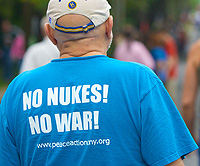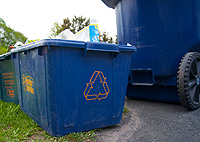Maxwell Perspective: Syracuse (sidebars)
July 7, 2012
Related:
Social Justice
Peaceniks
In peace and social justice, Syracuse offers choices.
 There are two well-established organizations in Syracuse with peace-advocacy agendas: the politically oriented Peace Action of Central New York and the grassroots Syracuse Peace Council. According to John Burdick, a professor of anthropology who has worked with both groups, their differences hint at a duality within peace movements.
There are two well-established organizations in Syracuse with peace-advocacy agendas: the politically oriented Peace Action of Central New York and the grassroots Syracuse Peace Council. According to John Burdick, a professor of anthropology who has worked with both groups, their differences hint at a duality within peace movements.
The 75-year-old Peace Council bills itself as the “longest continually existing peace and social justice organization,” says Burdick. Its causes (and strength)have evolved, but its emphases on principled demonstration and civil disobedience waver little. There is a “strong anarchist flavor” to their work, he says.
Peace Action arose in response to Reagan-era policies and assumed a broader agenda — defense budgets, anti-interventionism. This group, Burdick says, believes “you have to create a relationship with government if you want to effect change.”
Burdick says the two groups hint at Syracuse’s strong, if sometimes hidden, progressive tradition, evidenced also in labor/religion coalitions, an active inter-faith council, liberal churches, and the Westcott Street bohemia. “It’s lively,” he says. “There is a strong presence of progressives and left-of-center types in Syracuse.”
—Dana Cooke
Community Nutrition
Tomato Patch
Syracuse’s urban gardening project started at Maxwell.
They’re called “food deserts” — large, poorer neighborhoods where the absence of grocery stores and patchy public transportation make access to good, fresh food tricky. One remedy is urban agriculture.
Syracuse Grows is an initiative with 13 local gardens. It is especially well-embraced in Syracuse’s refugee community. Bhutanese, Somali, and Congolese immigrants are actively growing peppers, tomatoes, pumpkins, and greens on otherwise unused city lots made available to them.
Maxwell-based Community Geographer Jonnell Allen Robinson is co-founder of Syracuse Grows. She integrated the sort of land-use data and food-access statistics her office normally analyzes with insights from the community to help start the project.
The Community Geographer office was created in 2005 (with support from the Gifford Foundation) to provide geographical analysis to governments and groups grappling with municipal challenges. Projects that Robinson informs range from hydro-fracking permit mapping to a study of pedestrian safety for school children.
Syracuse Grows is looking at mobile markets and co-ops as another source of fresh food. “The challenges of helping the poor have access to food,” Robinson says, “are so enormous that the only way to do it is to be extremely creative.”
—Sabith Khan
Public Transportation
The Cost of a Ride
Fares don’t pay for buses, and public funds don’t quite either.
Public transportation in Syracuse is coordinated by Centro, part of a larger authority with 675 buses in four counties.
In Syracuse, an average of 31,000 passengers per day ride Centro, but fares from these riders generate only 21 percent of operating revenue. Yet inherent to a bus company’s operation is the fact you can’t charge riders enough to meet costs, especially as bus maintenance and fuel grow more expensive.
Therefore Centro depends on state funds — a mortgage tax that is slumping with the economy. In its 2012 budget, Centro faced a deficit of almost $4.8 million. At public hearings, riders stressed the importance of public transportation in their daily lives; many said they were willing to pay higher fares to prevent route cuts. So in May a downtown ride rose from $1.25 to $2 (the highest such fare in the state).
According to Richard Lee ’99 MA (PA), vice president of administration at Centro, the fare hike was painful but necessary. “Reducing service is counter to our mission,” he says; responsibility to taxpayers and concern for “future financial stability demanded it.”
—Emily Kaufman
Education
Say Yes
A district-wide program offers some hope to city schools.
Syracuse City Schools are suffering. The 2009 graduation rate was 49.5 percent, with only 14.7 percent of graduates college-ready, according to the state. Meanwhile, at press time the district faced a 6.4-percent budget reduction and proposed to cut 584 jobs.
There’s hope in Say Yes to Education, a national foundation devoted to increasing graduation rates for inner-city youth by providing academic, social, and health supports. Syracuse is the first city to implement Say Yes district-wide.
It provides after-school and summer school programs and, most significantly, offers free college tuition for students who attend Syracuse public schools (grades 10-12) and meet college admissions requirements. There are now a thousand Syracuse Say Yes students in college.
District Superintendent Daniel Lowengard ’72 BA (PSc), who retires at the end of this year, says Syracuse is a demonstration site for economic development and school reform. “No city has truly embraced the mission of raising children from poverty to post-secondary education completion,” he believes. “No blueprint exists, no silver bullet.” Say Yes, he says, channels community stakes: “The public must be more actively engaged in advocating support for our students.”
—Emily Kaufman
Waste Management
Beyond Blue Bins
New York’s top recycling program keeps pushing.
 Onondaga County recycles 60 percent of its waste — “and, per capita, more material than any other large community in New York,” says Andrew Radin ’91 MPA, director of recycling for the Onondaga County Resource Recovery Agency.
Onondaga County recycles 60 percent of its waste — “and, per capita, more material than any other large community in New York,” says Andrew Radin ’91 MPA, director of recycling for the Onondaga County Resource Recovery Agency.
OCCRA was launched in 1990 to oversee recycling, other re-use programs, and a waste-to-energy incinerator; its services are shared by Syracuse and all but two municipalities in the county. Recycling was championed by the late Suzanne LaLonde ’85 MPA, Radin’s predecessor. He credits her environmental commitment and political savvy with seeding citizen enthusiasm that continues today.
“If we set the bar high and make it clear what the benefits are,” Radin says, “we shouldn’t be surprised the community responds in an excellent fashion.”
For household recyclers, curb-side blue bins are iconic, a symbol of involvement. But Radin says 80 percent of recyclables come from institutions (schools, business, industry, hospitals and other care centers, etc.), with whom OCCRA partners ambitiously. The push now is for food waste, which OCCRA hopes to collect for composting.
Garbage is not glamorous, Radin admits, but working for OCCRA taps personal principles: “I don’t think you do this unless you care about recycling and waste management.”
—Dana Cooke
Crime and Justice
Guns, Drugs, Gangs
Syracuse’s location affects the type of crime it sees.
Syracuse’s location at the crossroads of the state makes it vulnerable for illegal narcotics and gun trafficking. “We have a steady caseload of drug traffickers bringing drugs up from New York City,” says Onondaga County District Attorney William J. Fitzpatrick ‘74 BA (PSc).
“Illegal drugs and the drug trade are inextricably interwoven with gangs and gun violence,” says Fitzpatrick. “Drug traffic and gangs tear at the basic fabric of neighborhoods and destroy inner city communities.”
Fitzpatrick works with the U.S. Attorney’s Office to prosecute gangs under the federal RICO statute, while a multi-pronged Gang Violence Task Force combats the issue at local, state, and federal levels.
And, since a large percentage of crime is committed by a small percentage of offenders, Fitzpatrick’s office also coordinates Operation IMPACT, a multi-agency collaboration using intelligence and crime data to target “hot spots” of gun violence or drug trafficking — directing enforcement toward what Fitzpatrick calls, “our worst chronic offenders.” Since 2008, 71 targets were arrested, resulting in 37 indictments.